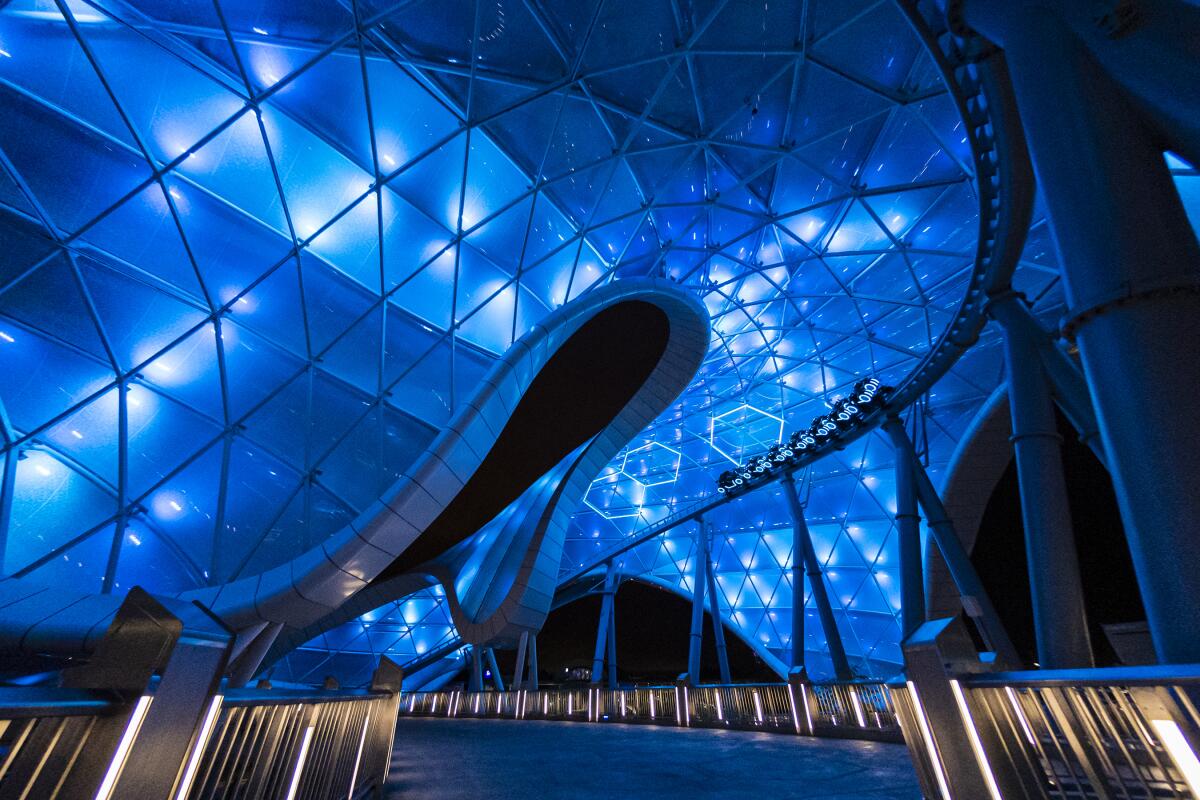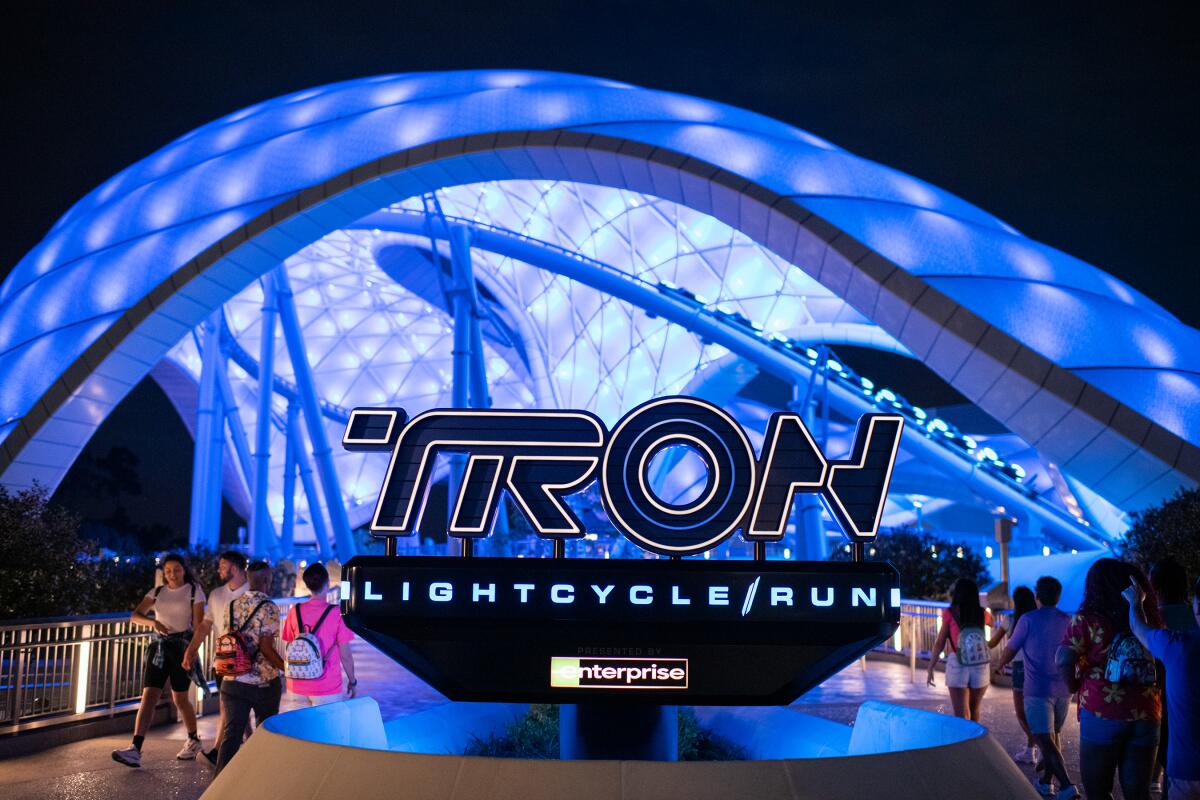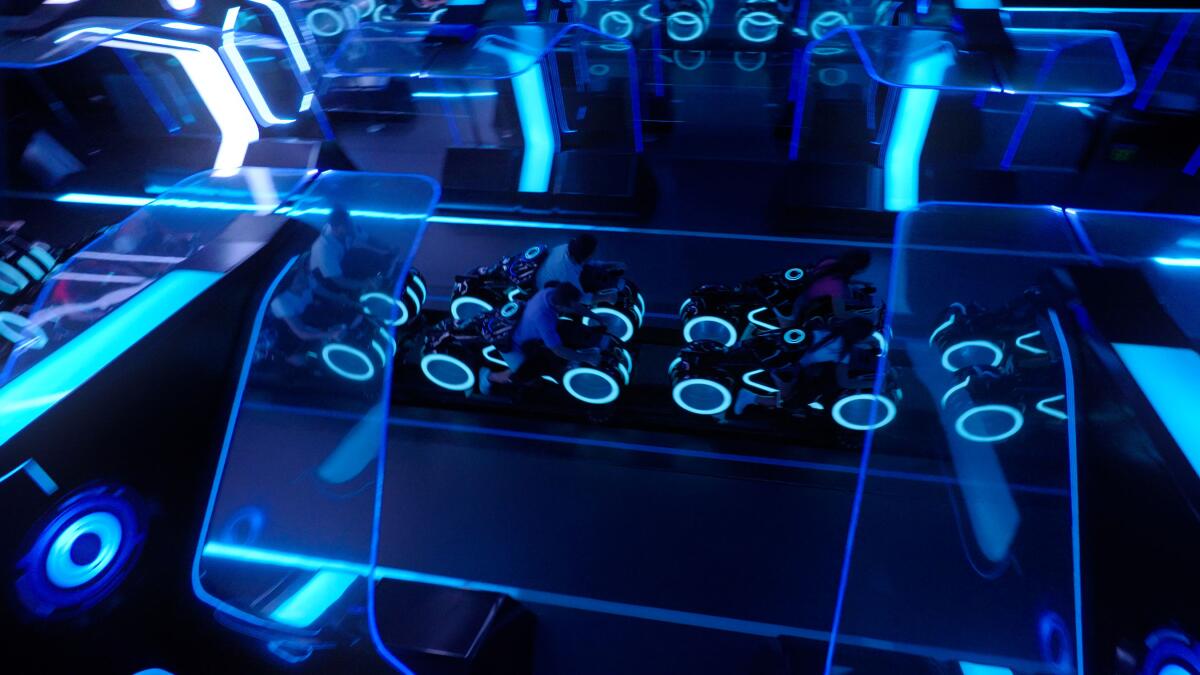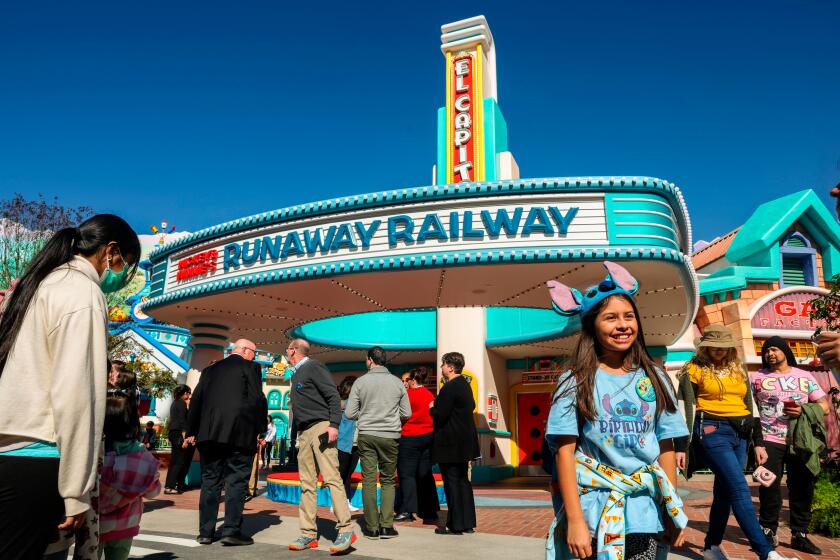Walt Disney World’s new Tron ride: Gorgeous, but not the next Space Mountain

- Share via
Orlando, Fla. — The skyline of Walt Disney World’s Tomorrowland has long been marked by the circular dome and star-reaching spires of Space Mountain, a cylindrical building whose decorative lines are constantly pointing skyward. In Florida, Space Mountain is nestled close to the Contemporary Resort and is easily visible to those taking transportation and walking to the Magic Kingdom. It stands as a symbol of optimism, a mid-1970s structure that dreams upward and celebrates the promise of discovery via space travel.
The new Tron Lightcycle / Run — yes, that is how it is stylized — doesn’t exactly look like a building. Its entrance is a grand canopy, one that is designed to match the sense of motion of the roller coaster nestled under it. All glistening white curves and otherworldly flows, the entrance to Lightcycle / Run recalls gorgeous architectural works — I think of the Frank Gehry-designed bridge and pavilion of Chicago’s Millennium Park, where steel panels wind us through an urban park and frame the greenery and skies with a sense of wonder.
As a sight, it’s a triumph — a building for a ride inspired by a movie about video games — a ride that feels like a video game — that still can evoke a sense of comfort while looking like nothing else in a Disney theme park. It works with Space Mountain, as both are terminals to other places — Space Mountain to the horizons and Lightcycle / Run to our digital-focused universe of today and likely tomorrow. The latest addition to Walt Disney World’s Magic Kingdom, the ride opens April 4, with a soft opening set for March 20. The attraction brings a unique vehicle to a Disney theme park, and makes the argument that video games are the dominant cultural medium of our time.

The ride is an import, first opening at Shanghai Disneyland in 2016, and announced for Walt Disney World in 2017. It brings a much-needed new attraction to the Magic Kingdom, the most visited theme park on the planet, and it stands as one of the fastest coasters ever created by Walt Disney Imagineering. It’s short — the ride is only about a minute long, if one doesn’t count some preshow magic tricks in the queue — but Disney reps said it could hit 60 miles per hour, and it does so quickly.
Though “Tron” may appear like a slightly unlikely franchise to bring to American audiences — here in the States “Tron” was a success, but it’s by no means one of the company’s most recognizable franchises — I see it more as an acknowledgment that today’s audiences were weaned on the interactivity of video games and increasingly expect content that reflects that. Disney has created an elaborate backstory for how the attraction fits into the world of “Tron,” but prior knowledge isn’t really needed: We are digitized and brought into a blacklighted video game arena to have a Lightcycle race against another computerized team.
One quick thing to note: The ride vehicles feel great. Even if “Tron” isn’t a brand on par with Marvel or “Star Wars,” those neon-lit motorcycles — the Lightcycles — are indeed recognizable, and one glimpse of them and their panther-like slickness and we wish we could get on one. We can, and the attraction stands as Disney’s first motorcycle-like coaster, as in guests will straddle a seat and lean forward as if on an actual motorbike. Pulling back on the metal handlebars and being locked into the attraction is probably my favorite moment of the ride, as instantaneously we feel as if we are entering a fantasy vehicle.
At long last, Disneyland has a ride themed to Mickey Mouse. The new Mickey and Minnie’s Runaway Railway is a charmer, a lighthearted addition to Toontown that celebrates modern animation.
Early social media reaction has focused heavily on the accessibility of the attraction. Getting on the ride will require some light flexibility, as these coaster seats are robust, but in a number of ride-throughs at a prerelease media event I witnessed only one guest having trouble being locked into a seat. An informal sampling, of course, but I know of not-small people who haven’t had an issue on the vehicles when they visited Shanghai Disneyland, and until theme parks more openly acknowledge restrictions on new thrill rides, it will be a source of social media speculation and backlash.
But while it’s true that one’s body type could affect their ability to ride a Lightcycle, some coaster trains are outfitted with rather large-but-standard coaster cars in the back. While some may choose this option to avoid the heightened thrills of the Lightcycle, there’s a worthy debate to be had over theme park design and rider accessibility, and as audiences demand more thrills and unique ride experiences, such a conversation isn’t going to disappear. (An Imagineering rep declined to discuss any specifics on the ride vehicle’s accessibility.)
Let’s get to the actual ride experience. The good news: Lightcycle / Run is fun. The bad news: It’s short, and overall feels slight.
The actual ride, for instance, doesn’t match the ambition of the building it’s housed in, as once we’re off, we’re off, and the ride could use an extra 20 or 30 seconds, with the understanding that the faster coasters become, the quicker the ride will be. We first travel outside and under the canopy — twinkling at night but white-bright during the day. I don’t really have a day or night preference, as both frame the riders with airiness and allow us to feel as if we are traveling somewhere new.
That place is the video game-like darkened show building, and the moment we enter is the strongest part of the coaster, as we take a slight dip and a quick turn. As our eyes adjust to the darkness, the track is largely invisible, and if you’re on a Lightcycle, expect a freeing sensation as the ride vehicle leans to its left. There are projections of our ride competitors, and digitized gates we have to pass through to successfully complete the game-like trappings of the experience.

In terms of Disney thrill rides, it’s fast, it’s sleek and it does indeed provide a thrill. But after spending a couple of days in Walt Disney World, and revisiting coasters such as its Big Thunder Mountain Railroad, ever-so-slightly longer than our Anaheim version, Space Mountain, Epcot’s Guardians of the Galaxy: Cosmic Rewind and Animal Kingdom’s Expedition Everest, Lightcycle / Run felt a bit lacking in ambition. It’s counting on the uniqueness of the ride vehicle and its speed more than its theming or even coaster design.
I missed the sensation I had after riding Expedition Everest for the first time, and marveling at the mysteries hidden inside an elaborately detailed mountain. While Disneyland’s Space Mountain is superior to Walt Disney World’s version, I feel that ride captures a sense of explorer’s optimism, and Big Thunder Mountain, on both coasts, is full of lifts and turns with a track built cleverly into the landscape to keep us guessing. With an assortment of critters, fossils and dangers, there’s no shortage of design to grab our attention and stroke our sense of wonder. Even the new Guardians of the Galaxy: Cosmic Rewind at Epcot, though given a too-elaborate setup, puts us in vehicles that twist and turn and feel as if we’re dancing on a track, a sensation built for surprise.
Lightcycle / Run will please guests — I was happy the first time I rode it, after all — but I worry it lacks a level of repeatability that other coasters at Disney possess (many of which better highlight Imagineering’s famed attention to detail). And given how crowded Disney theme parks are these days, the actual time in the coaster vehicle — again, about a minute — feels too short. The computerized innards of the queue, as well as a brief illusion that introduces guests to the digital world, are well done, but for a ride that aims to transport us into a video game, and place us in a race against other Lightcycles, opportunities were missed to heighten the tension, either in track design or a show building design that could allow for more elaborate projections of our competitors.
Ultimately, Lightcycle / Run seems a victim of Disney’s own prior successes. Big Thunder Mountain, for instance, remains a masterpiece, and when it was introduced at Disney parks in the late 1970s and early ’80s felt epic in design, arguing that the roller coaster could tell a story as well as it could provide a thrill. Lightcycle / Run plays it more simple, emphasizing pure entertainment rather than theme park awe.
However, the new ride does have timing on its side. In an era when theme park rides are increasingly interactive — and video games are dominating pop culture and being adapted to film and television at a rapid pace — a ride that places us inside a video game race feels of-the-moment in 2023. And for being inspired by a 1982 film and its 2010 sequel, that may be Lightcycle / Run’s greatest accomplishment.
More to Read
The biggest entertainment stories
Get our big stories about Hollywood, film, television, music, arts, culture and more right in your inbox as soon as they publish.
You may occasionally receive promotional content from the Los Angeles Times.












